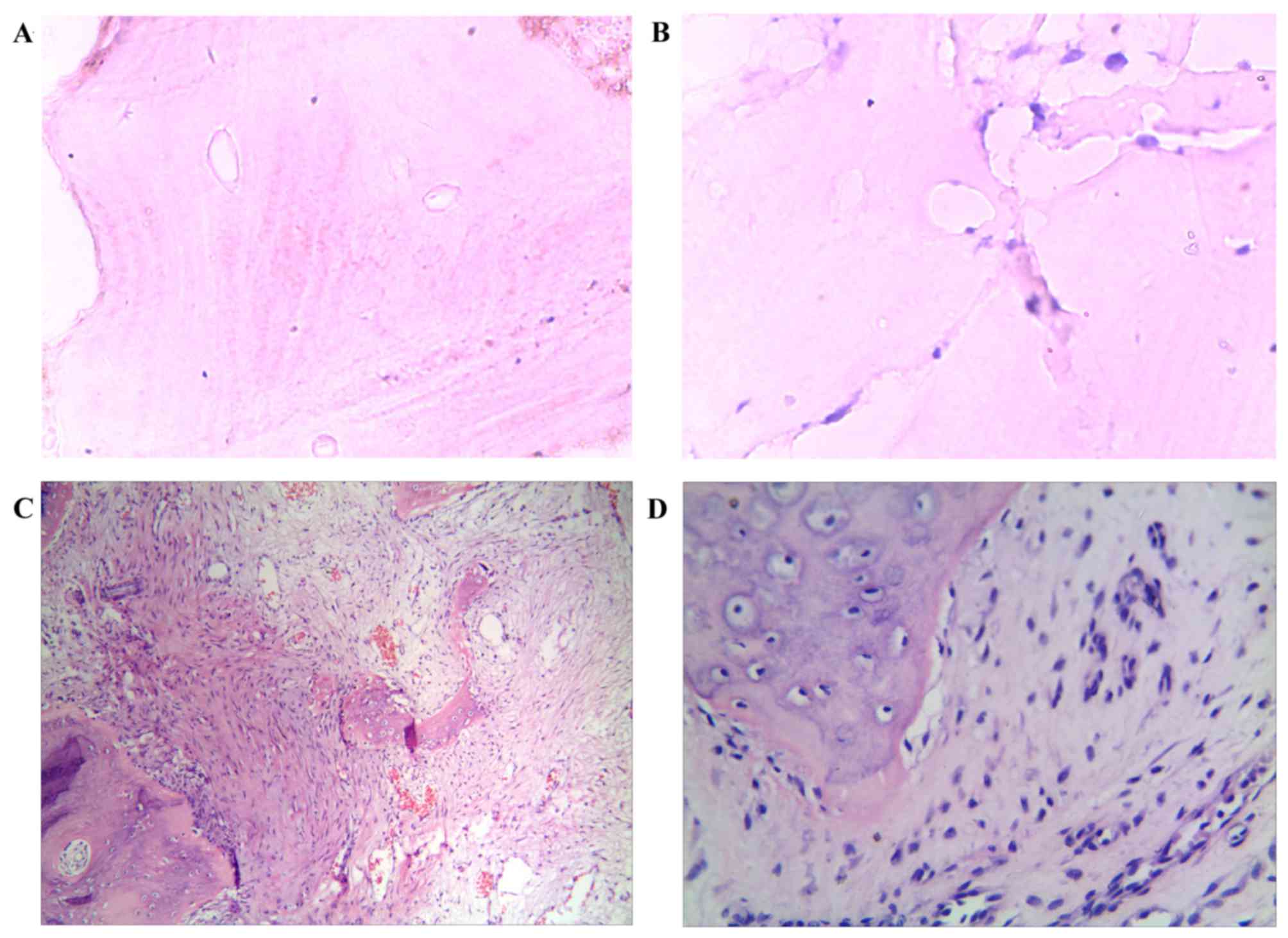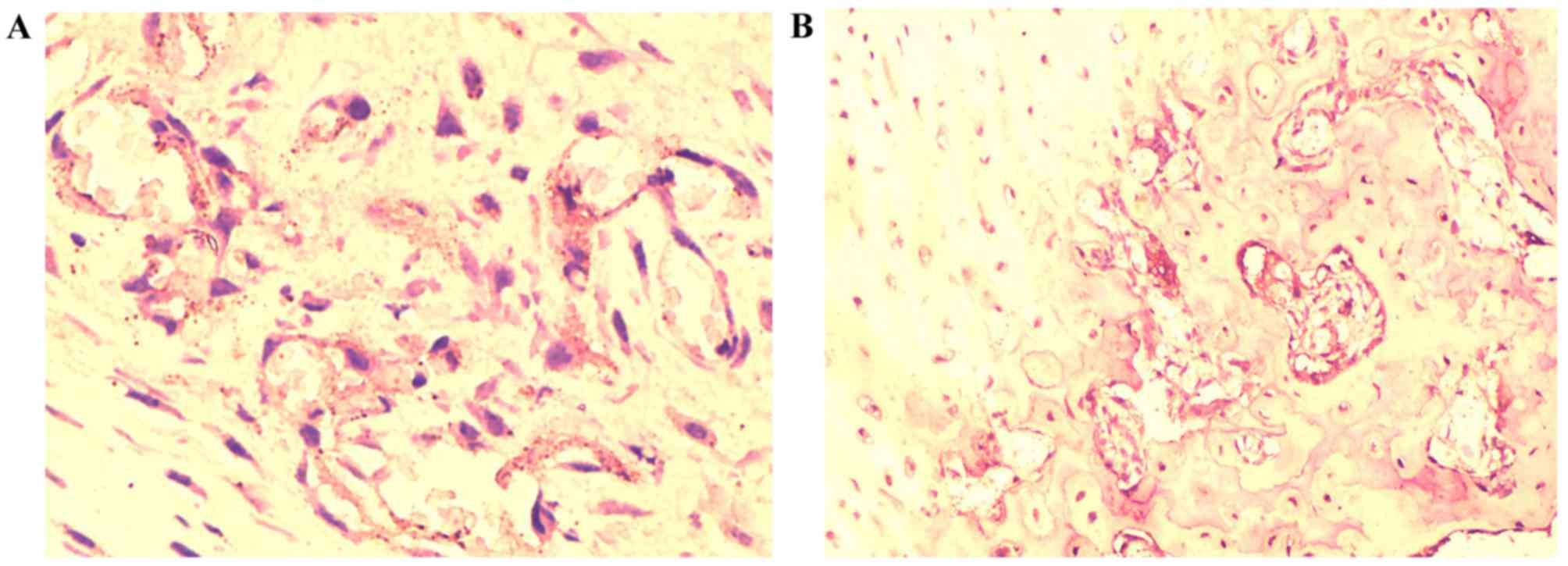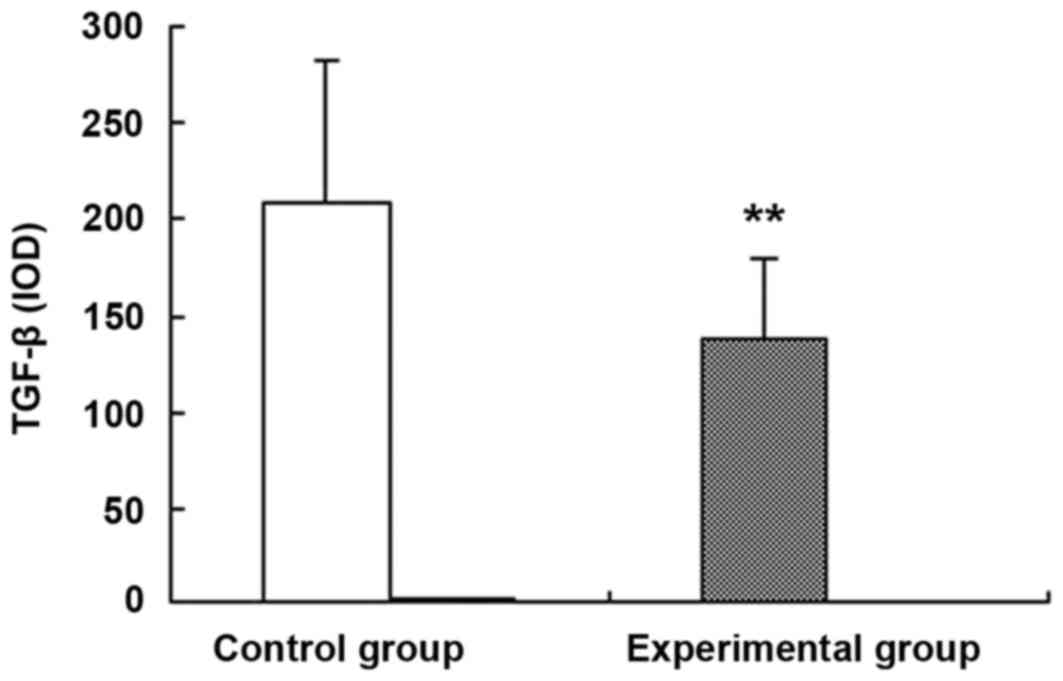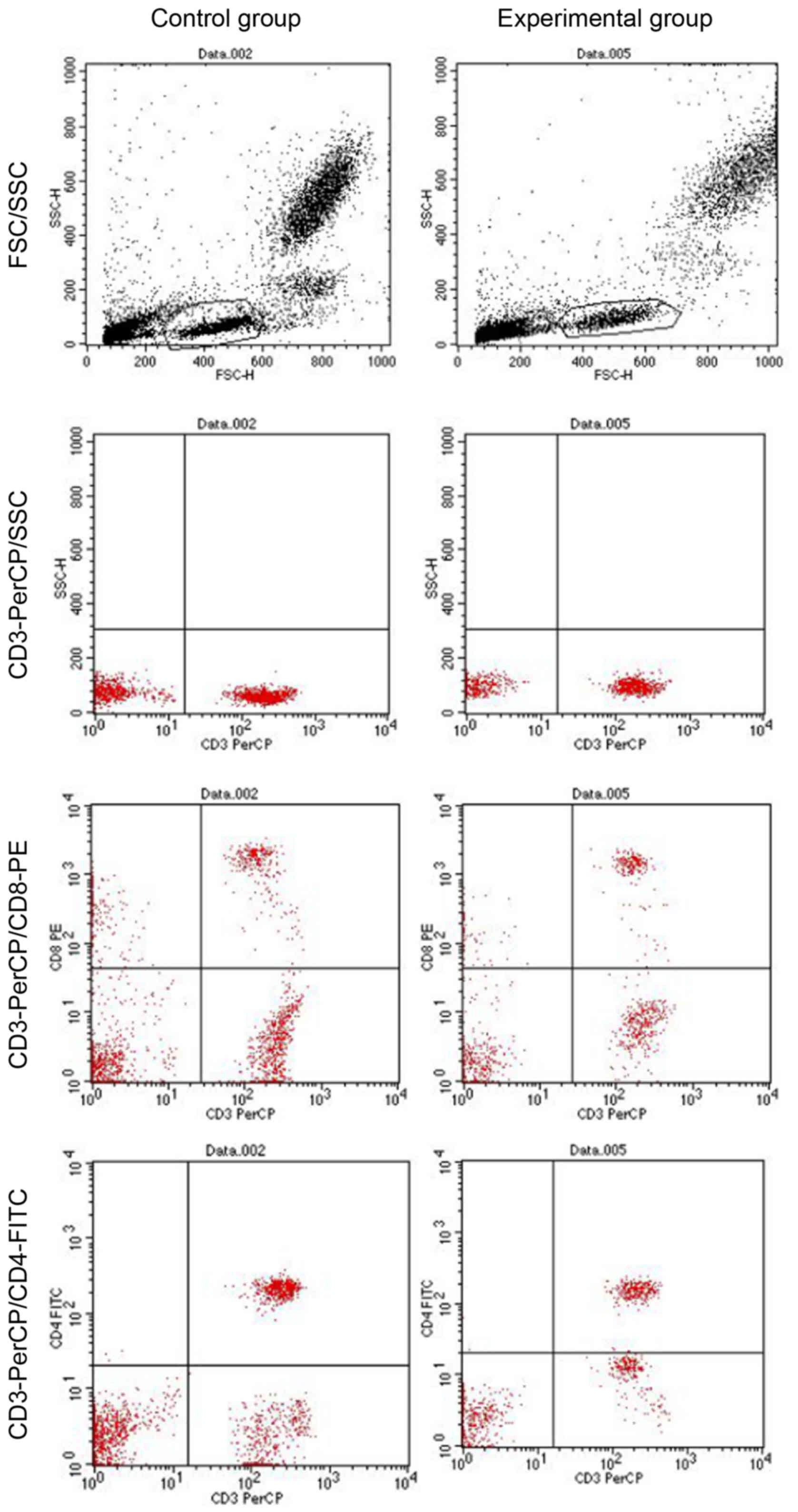TGF‑β1 expression in adults with non‑traumatic osteonecrosis of the femoral head
- Authors:
- Published online on: October 19, 2017 https://doi.org/10.3892/mmr.2017.7817
- Pages: 9539-9544
Abstract
Introduction
Non-traumatic osteonecrosis of the femoral head (NONFH) is a common clinical osteoarthropathy resulting from the interruption of blood supply to the femoral head following an insulting event (1). In the past decade, there has been a steady increase in the worldwide prevalence of NONFH, owing to the growing risk factors, increased public awareness of the disease and as a side effect of multiple medications, for example, corticosteroids (2). A nationwide survey conducted from 2012 to 2013 in China revealed a 0.7% prevalence in tested subjects, which in translation estimated >8 million NONFH cases in the Chinese population aged ≥15 years (3).
Despite recent advances in the understanding of pathophysiologic mechanisms, NONFH remains a debilitating condition that may result in significant morbidity. The current clinical treatment modalities of NONFH include nonoperative conservative approaches, joint-preserving surgical procedures and total arthroplasty. Nonoperative conservative treatments are usually indicated in the precollapse disease. This ranges from lifestyle modifications such as weight-bearing restrictions, to physical therapies with electrical stimulation, extracorporeal shock wave, hyperbaric oxygen, and magnetic therapy, and medical management with nonsteroidal anti-inflammatory drugs or narcotics for symptomatic relief. Low molecular weight heparin has also been suggested to prevent the progression of precollapse osteonecrosis in thrombophilic patients. Dietary regimens and alternative medicine have also been tried, with their therapeutic efficacy still in debate (2). Most patients eventually require surgical interventions such as total hip arthroplasty (4,5).
Genetic and molecular biology studies have indicated that NONFH may be closely associated with environmental and genetic factors (3,6), and its pathological progression may involve cytokines, nuclear factor kappa-B (NFκ-B) (7,8), and transforming growth factors (9). For example, a small clinical study by Gómez-Mont Landerreche et al (7) demonstrated the use of pegylated interferon (IFN) in patients with hepatitis C was associated with bilateral avascular necrosis of the femoral head.
Transforming growth factor β1 (TGF-β1) is a member of the TGF-β superfamily of cytokines and serves a crucial role in diverse cellular processes such as proliferation, differentiation, apoptosis and immune regulation (10,11). TGF-β1 has been studied for its implication in the pathogenesis of NONFH, and has been proposed as a therapeutic target for NONFH management (9). Overexpression of TGF-β1 was observed in the transition area between vascular tibia grafts and irradiated bone in an experimental model of osteonecrosis (12).
However, there has been no direct investigation of TGF-β1 in a clinical model of NONFH. The present study determined the association between TGF-β1 expression, necrotic bone architecture and remodeling, and systemic inflammation in NONFH. This may further understanding of the pathophysiology of NONFH, and provide a mechanistic basis for the clinical development of TGF-β1 targeted therapy for the conservative management of NONFH.
Materials and methods
Patients
Patients (3 males and 17 females) aged between 35 and 56 years were admitted and received hip replacement surgery between October 2013 and October 2014, and were recruited from the Department of Orthopaedics at Huainan People's Hospital (Huainan, China). They had no previous history of trauma and surgery. This experimental group comprised 20 cases: 16 patients had stage III NONFH and 4 patients with stage IV NONFH. The control group (9 males and 11 females) aged between 32 and 57 years, comprised 20 cases of fresh femoral neck fractures but with no other chronic diseases or family history of genetic disorders. The study was approved by the Ethics Committee of Huainan People's Hospital (Huainan, China). All participants provided written informed consent.
Ficat-Arlet classification
The Ficat-Arlet classification was used to identify the stages of patients (13). Patients were classified according to the following criteria: i) Stage 0, no symptoms and normal radiograph (‘suspected stage’); ii) stage I, normal radiograph or mild diffuse osteoporosis; iii) stage II, the radiograph revealed signs of reconstruction but no alterations in the shape of the femoral head and the joint space, osteoporosis, osteosclerosis and cystic degeneration in the necrotic area, and a bone marrow core biopsy revealed histopathological alterations; iv) transitional stage, characterized by subchondral fracture (crescent sign) and localized flattening of the femoral head; v) stage III, the radiograph revealed sclerosis and cystic degeneration inside the femoral head, collapse of the femoral head, crescent sign and normal joint space; and vi) stage IV, the radiograph revealed the collapse of the femoral head and narrowing of the joint space.
Collection and processing of specimens
The femoral heads were collected during total hip replacement were cut in half along the coronal plane. Subsequently, a section of bone (1.0×1.0×0.3 cm) was obtained from the necrotic area and the adjacent non-necrotic area with a chisel, fixed with 4% paraformaldehyde (containing 0.1% DEPC) for 12 h, and placed in 13% EDTA (pH 7.0) for microwave decalcification. After 6–14 days, complete decalcification was confirmed as no resistance to puncture by a needle, and the bone sample was embedded in paraffin and cut into 5-µm thick sections.
Histology and immunohistochemistry
Hematoxylin and eosin (H&E) staining was performed to allow pathological examination of tissue sections. The expression of TGF-β1 was detected by immunohistochemistry. Bone tissues were embedded in paraffin, cut, and sections were placed onto slides. Slides were subsequently dewaxed and rehydrated. After antigen retrieval with 0.01 mol/l sodium citrate (Jing An Biological Technology, Shanghai, China), slides were blocked with 1% bovine serum albumin (Leagene Biotechnology, Beijing, China), and incubated at 4°C overnight with anti-TGF-β1 antibody (1:200; cat no. E-CL-H0109c; Boster Bioloigcal Technology, Pleasanton, CA, USA). After an overnight incubation, slides were washed with PBS, and then incubated in the dark at 37°C with a horse radish peroxidase-conjugated goat anti-mouse secondary antibody (1:50; R&D Systems, Inc., Minneapolis, MN, USA) for 30 min. After color development with 3,3′-diaminobenzidine (DAB; Leagene Biotechnology) and routine hematoxylin nuclear counterstain, the sections were observed, and images were captured by two associate chief physicians of the Department of Pathology at Huainan No. 1 People's Hospital. The integrated optical density (IOD) values were quantified using Image-Pro Plus software version 6.0 (Media Cybernetics, Inc., Rockville, MD, USA).
Flow cytometry
Flow cytometry followed the manufacturer protocol (BD Biosciences, Franklin Lakes, NJ, USA). The BD Multitest antibody kit (cat no. 342417; BD Biosciences) contained fluorescein isothiocyanate-labeled CD3 (clone SK7), PE-labeled CD8 (clone SK1), PerCP-labeled CD45 (clone 2D1, HLe-1) and APC-labeled CD4 (clone SK3). In brief, peripheral blood was collected via venipuncture and anticoagulated with EDTA (BD Trucoun tube; cat no. 342447). A total of 50 µl fresh blood was mixed with 20 µl antibody cocktail for 15 min at room temperature in the dark. Subsequently, erythrocytes were lysed with the supplied BD FACS lysis buffer. The mixture was analyzed with a BD FACSCanto II flow cytometry system. The CellQuest software CXP version 2.0 (BD Biosciences) was used to quantify the T-lymphocyte subsets in the peripheral blood.
Statistical analysis
Statistical analyses were performed using SPSS software version 16.0 (SPSS, Inc., Chicago, IL, USA). Data are expressed as the mean ± standard error. Differences among 3 or more groups were compared by analysis of variance followed by the Bonferroni post-hoc test for multiple comparisons. Differences among 2 groups were compared by unpaired t-test. P<0.05 was considered to indicate a statistically significant difference.
Results
Radiological findings
Radiograph A revealed that In the experimental group, patients with stage IV NONFH had the typical manifestations of the disease, including deformation and collapse of the femoral head, narrowing of the joint space, loss of the articular cartilage, and formation of acetabular osteophytes. Radiograph B revealed that in the control group, there were signs of bone discontinuity and soft tissue incarcerated between the two ends of fracture, including a femoral neck fracture (data not shown).
Histological findings
The control group cartilage was thick, there was active osteogenesis, the bone trabeculae was regularly arranged, the circumferential lamellae appeared to be closely and regularly arranged in parallel, the osteocyte lacunae were located between or within the lamellae and were dispersively arranged, there was no osteonecrosis or proliferation of fibrous tissues (Fig. 1A and B). In the experimental group, the cartilage was thin, the subchondral trabeculae became thin with increased spacing and collapse, the absence of osteocyte lacunae was evident and the circumferential lamellae were not arranged in order. This was accompanied by the dissolution or fracture of lamellae, the necrosis and disintegration of osteocytes, and karyopyknosis and karyorrhexis were visible (Fig. 1C and D). In the surrounding tissues, hyperemia and edema were present and lymphocyte and plasma cell infiltration, bone marrow necrosis and proliferation of fibrous granulation tissues were also evident (Fig. 1C and D).
Immunohistochemical findings
Following immunohistochemical staining, the brown granules inside the femoral head were visible and were considered to indicate specific TGF-β1 expression. TGF-β1 expression was present in experimental and control groups. In the experimental group, expression was markedly reduced in the necrotic area and was present only in the surrounding area, whereas in the control group, TGF-β1 expression was primarily located in the cytoplasm, nucleus and plasma membrane of osteocytes (Fig. 2). The positive expression area in the experimental group was reduced compared with the control group (Fig. 2).
Image-Pro Plus software was used to perform a semi-quantitative analysis of the IOD values of TGF-β1 expression (Fig. 3). The mean IOD value in the control group was 209±73, whereas the experimental group was 137±43; therefore, the expression of TGF-β1 in the experimental group was significantly reduced compared with the control group (P<0.01; Fig. 3).
Detection of T-lymphocyte subsets
CellQuest software was used to detect the percentages of CD3+, CD4+ and CD8+ cells and the ratio of CD4+ to CD8+ cells. The findings revealed that the experimental group had reduced CD3+ and CD4+ cell populations (P<0.05, P<0.01), an increased CD8+ population (P<0.05) and a reduced ratio of CD4+ to CD8+ cells, compared with the control group (P<0.01; Fig. 4 and Table I).
Discussion
The typical pathological features of NONFH include decreased density of the femoral head, cystic degeneration of the bone, fracture of the trabecular structure and deformity and collapse of the femoral head (14). However, bone injuries that may not be detected by radiographic examinations are often present during the initial stage of NONFH. At this stage, cells in the local tissues initiate the complex mechanism underlying repair via the production of various cytokines including IL-17A, IFN-γ and TNF-α (15). The molecular mechanism underlying these events remains to be elucidated and when it fails to prevent the progression of bone injuries, structural damage and dysfunction of the bone will occur due to local osteonecrosis that increases with the progression of NONFH. The structural injury to the femoral head deteriorates with such progression and self-repair functions will be limited (14–17). The pathological alterations of avascular necrosis of the femoral head contribute to a sequential process that deteriorates and progresses rapidly.
As aforementioned, the healing and repair of bone tissue following trauma is a complex and continuous process that involves multiple cytokines such as interferons and transforming growth factors, and an array of intracellular signaling pathways, including the NF-κB and TGF-β/bone morphogenic protein signaling (18–22).
TGF-β1 is a member of TGF-β superfamily, the primary biological functions of which include the regulation of cell growth, immune activity and extracellular matrix components (23–25). Previous studies have confirmed that promoting the secretion and synthesis of extracellular matrix components is a primary mechanism responsible for the effect of TGF-β1 on osteogenesis, in which TGF-β1 may regulate osteoblast proliferation and differentiation, stimulate new bone formation, inhibit matrix metalloproteinase activity, and prevent the degradation of matrix macromolecules, thereby promoting bone formation (26–30). In addition, TGF-β1 may be involved in the early process of callus formation.
Therefore, TGF-β1 is an important cell signaling factor in the regulation of the trauma-healing processes, which is involved in the growth and differentiation of osteocytes and the synthesis of the extracellular matrix. The extracellular matrix is a structural complex formed by collagens, non-collagenous glycoproteins, hyaluronan and proteoglycans. It is not only a scaffold for embedded cells, but it is also a reservoir for various growth factors and cytokines necessary for cell activation and turnover. Thus, the extracellular matrix is critical for the development of cartilage and bone, and the repair and healing process following a bone fracture.
TGF-β1 is involved in almost all trauma-healing processes and it is widely distributed in the bone tissues, platelets and cartilage; therefore, it may additionally be involved in the process of new bone formation following avascular necrosis of the bone. The results of the present study suggested that TGF-β1 was expressed in the control group, which may indicate good bone repair capacity. By comparison, the expression of TGF-β1 in the necrotic areas of NONFH was significantly decreased. This was likely a reflection of diminished expression of TGF-β1, or that few cells remained variable in the necrotic area. In either case, TGF-β1 downregulation was associated with a reduced bone repair capacity. The experimental group had significantly downregulated TGF-β expression compared with the control group (P<0.01). Therefore, TGF-β may have a crucial role in the formation of new bone in the control group, whereas it was significantly inhibited in the experimental group. The histopathological findings additionally revealed that there was new bone formation and reduced osteonecrosis and trabecular destruction in the control group, whereas in the experimental group, novel bone tissues were negligible and there was severe osteocyte necrosis, trabecular destruction and extensive lymphocyte infiltration. The findings of the present study revealed that the control group had active TGF-β1 expression. Therefore, patients in the control group retained bone repair capacity following traumatic osteonecrosis of the femoral head, whereas the experimental group had reduced bone tissue regeneration capacity and their bone repair capacity was absent. Furthermore, the present study determined that the experimental group had numerous fibrous granulation tissues surrounding the necrotic femoral head, whereas the control group had few fibrous granulation tissues; this provided further evidence that patients with NONFH had reduced bone repair capacity.
T lymphocytes serve an important role in the regulation and maintenance of the immune system and clinically, the immune status of patients may be assessed by quantification of the T-lymphocyte subsets, which is additionally important for the diagnosis and prognosis of patients' condition. T lymphocytes may be divided into different subsets according to their surface markers. The CD4+ cell population contains helper T cells. The CD8+ cell population contains suppressor T cells, which are also termed cytotoxic T cells. The two subsets suppress and aid each other to maintain the balance of immune functions. In the present study, T-lymphocyte subsets in the peripheral blood were detected by the flow cytometry. It was determined that the percentage of CD3+ T cells in the experimental group peripheral blood was reduced compared with the control group. The percentage of CD4+ cells in the experimental group was decreased compared with the control group. Additionally, the percentage of CD8+ cells in the experimental group was increased. The CD4+/CD8+ ratio in the experimental group was reduced compared with the control group, which may suggest damaged immune functions and abnormal generation or function of T cells in patients with NONFH.
Regardless of the cause of NONFH, chronic inflammatory reactions were present in the experimental group and the alterations in T-lymphocyte subsets may be an indication of various inflammatory reactions. Therefore, abnormal percentages of CD3+, CD4+ and CD8+ cells, and the altered ratio of CD4+ to CD8+ cells suggested that chronic inflammatory reactions and immune regulation were present in patients with NONFH. Additionally, important events in NONFH pathology occur due to various factors; therefore, the detection of T-lymphocyte subsets may be crucial for successful clinical treatment and prognosis. It would be of interest to incorporate heathy control femoral heads, perhaps harvested postmortem, for a pairwise comparison in a future study. This would allow further delineation in the differences in TGF-β1 expression, histological alterations, and systemic T-lymphocyte mediated inflammation observed in the current study.
In conclusion, the present study revealed that decreased TGF-β1 expression was associated with altered bone architecture and remodeling, and systemic immune functions in adult patients with NONFH. TGF-β1 is a cytokine involved in various processes. The present study supports the notion that exogenous introduction of TGF-β1, either by direct intraarticular injection or targeted overexpression, may be an effective treatment for bone injuries and bone repair at certain stages of NONFH. However, substantial future work is required to understand the complex underlying mechanism of mutual regulations of multiple cytokines, as is the complete decipher of principles underlying bone self-repair and regeneration in NONFH.
Acknowledgements
The present study was supported by the Science and Technology Plan Project of Huainan (grant no. 2015012), and the Doctoral Fund Project of Anhui University of Science and Technology (grant no. 11740).
References
|
Mont MA, Jones LC and Hungerford DS: Nontraumatic osteonecrosis of the femoral head: Ten years later. J Bone Joint Surg Am. 88:1117–1132. 2006. View Article : Google Scholar : PubMed/NCBI | |
|
Mont MA, Cherian JJ, Sierra RJ, Jones LC and Lieberman JR: Nontraumatic osteonecrosis of the femoral head: Where do we stand today? A ten-year update. J Bone Joint Surg Am. 97:1604–1627. 2015. View Article : Google Scholar : PubMed/NCBI | |
|
Zhao DW, Yu M, Hu K, Wang W, Yang L, Wang BJ, Gao XH, Guo YM, Xu YQ, Wei YS, et al: Prevalence of nontraumatic osteonecrosis of the femoral head and its associated risk factors in the Chinese population: Results from a nationally representative survey. Chin Med J (Engl). 128:2843–2850. 2015. View Article : Google Scholar : PubMed/NCBI | |
|
Tan G, Kang PD and Pei FX: Glucocorticoids affect the metabolism of bone marrow stromal cells and lead to osteonecrosis of the femoral head: A review. Chin Med J (Engl). 125:134–139. 2012. View Article : Google Scholar : PubMed/NCBI | |
|
Zalavras CG and Lieberman JR: Osteonecrosis of the femoral head: Evaluation and treatment. J Am Acad Orthop Surg. 22:455–464. 2014. View Article : Google Scholar : PubMed/NCBI | |
|
Pouya F and Kerachian MA: Avascular necrosis of the femoral head: Are any genes involved? Arch Bone Jt Surg. 3:149–155. 2015.PubMed/NCBI | |
|
Gómez-Mont Landerreche JG, Gil-Orbezo F, Morales-Dominguez H, Navarrete-Álvarez M, Trueba-Davalillo C and Capuano-Tripp P: Nontraumatic causes of bilateral avascular necrosis of the femoral head: Link between hepatitis C and pegylated interferon. Acta Ortop Mex Mex and pegylated interferon. Acta Ortop Mex. 29:172–175. 2015.(In Spanish). PubMed/NCBI | |
|
Farrier AJ, Franco LC Sanchez, Shoaib A, Gulati V, Johnson N, Uzoigwe CE and Choudhury MZ: New anti-resorptives and antibody mediated anti-resorptive therapy. Bone Joint J. 98-B:1–165. 2016. View Article : Google Scholar : | |
|
Mont MA, Jones LC, Einhorn TA, Hungerford DS and Reddi AH: Osteonecrosis of the femoral head. Potential treatment with growth and differentiation factors. Clin Orthop Relat Res. (355 Suppl): S314–S335. 1998. View Article : Google Scholar : PubMed/NCBI | |
|
Letterio JJ and Roberts AB: Regulation of immune responses by TGF-beta. Annu Rev Immunol. 16:137–161. 1998. View Article : Google Scholar : PubMed/NCBI | |
|
Massagué J: TGF-beta signal transduction. Annu Rev Biochem. 67:753–791. 1998. View Article : Google Scholar : PubMed/NCBI | |
|
Schultze-Mosgau S, Lehner B, Rödel F, Wehrhan F, Amann K, Kopp J, Thorwarth M, Nkenke E and Grabenbauer G: Expression of bone morphogenic protein 2/4, transforming growth factor-beta1, and bone matrix protein expression in healing area between vascular tibia grafts and irradiated bone-experimental model of osteonecrosis. Int J Radiat Oncol Biol Phys. 61:1189–1196. 2005. View Article : Google Scholar : PubMed/NCBI | |
|
Mouzas OD, Zibis AH, Bonotis KS, Katsimagklis CD, Hadjigeorgiou GM, Papaliaga MN, Dimitroulias AP and Malizos KN: Psychological distress, personality traits and functional disability in patients with osteonecrosis of the femoral head. J Clin Med Res. 6:336–344. 2014.PubMed/NCBI | |
|
Ficat RP: Idiopathic bone necrosis of the femoral head. Early diagnosis and treatment. J Bone Joint Surg Br. 67:3–9. 1985.PubMed/NCBI | |
|
Zhang H, Xiao F, Liu Y, Zhao D, Shan Y and Jiang Y: A higher frequency of peripheral blood activated B cells in patients with non-traumatic osteonecrosis of the femoral head. Int Immunopharmacol. 20:95–100. 2014. View Article : Google Scholar : PubMed/NCBI | |
|
Zheng L, Wang W, Ni J, Li Z and Xiao T: The association of eNOS gene polymorphism with avascular necrosis of femoral head. PLoS One. 9:e875832014. View Article : Google Scholar : PubMed/NCBI | |
|
Hong YC, Luo RB, Lin T, Zhong HM and Shi JB: Efficacy of alendronate for preventing collapse of femoral head in adult patients with nontraumatic osteonecrosis. Biomed Res Int. 2014:7165382014. View Article : Google Scholar : PubMed/NCBI | |
|
Sakaguchi M, Tanaka T, Fukushima W, Kubo T and Hirota Y; Idiopathic ONF Multicenter Case-Control Study Group, : Impact of oral corticosteroid use for idiopathic osteonecrosis of the femoral head: A nationwide multicenter case-control study in Japan. J Orthop Sci. 15:185–191. 2010. View Article : Google Scholar : PubMed/NCBI | |
|
Lykissas MG, Gelalis ID, Kostas-Agnantis IP, Vozonelos G and Korompilias AV: The role of hypercoagulability in the development of osteonecrosis of the femoral head. Orthop Rev (Pavia). 4:e172012. View Article : Google Scholar : PubMed/NCBI | |
|
Kapoor M, Martel-Pelletier J, Lajeunesse D, Pelletier JP and Fahmi H: Role of proinflammatory cytokines in the pathophysiology of osteoarthritis. Nat Rev Rheumatol. 7:33–42. 2011. View Article : Google Scholar : PubMed/NCBI | |
|
Hong JM, Kim TH, Kim HJ, Park EK, Yang EK and Kim SY: Genetic association of angiogenesis- and hypoxia-related gene polymorphisms with osteonecrosis of the femoral head. Exp Mol Med. 42:376–385. 2010. View Article : Google Scholar : PubMed/NCBI | |
|
Seamon J, Keller T, Saleh J and Cui Q: The pathogenesis of nontraumatic osteonecrosis. Arthritis. 2012:6017632012. View Article : Google Scholar : PubMed/NCBI | |
|
Plaas A, Velasco J, Gorski DJ, Li J, Cole A, Christopherson K and Sandy JD: The relationship between fibrogenic TGFβ1 signaling in the joint and cartilage degradation in post-injury osteoarthritis. Osteoarthritis Cartilage. 19:1081–1090. 2011. View Article : Google Scholar : PubMed/NCBI | |
|
Finnson KW, McLean S, Di Guglielmo GM and Philip A: Dynamics of transforming growth factor beta signaling in wound healing and scarring. Adv Wound Care (New Rochelle). 2:195–214. 2013. View Article : Google Scholar : PubMed/NCBI | |
|
Penn JW, Grobbelaar AO and Rolfe KJ: The role of the TGF-β family in wound healing, burns and scarring: A review. Int J Burns Trauma. 2:18–28. 2012.PubMed/NCBI | |
|
Bastian O, Pillay J, Alblas J, Leenen L, Koenderman L and Blokhuis T: Systemic inflammation and fracture healing. J Leukoc Biol. 89:669–673. 2011. View Article : Google Scholar : PubMed/NCBI | |
|
Yang H, Gao F, Li X, Wang J, Liu H and Zheng Z: TGF-β1 antagonizes TNF-α induced up-regulation of matrix metalloproteinase 3 in nucleus pulposus cells: Role of the ERK1/2 pathway. Connect Tissue Res. 56:461–468. 2015. View Article : Google Scholar : PubMed/NCBI | |
|
Rivas M Noval, Weatherly K, Hazzan M, Vokaer B, Dremier S, Gaudray F, Goldman M, Salmon I and Braun MY: Reviving function in CD4+ T cells adapted to persistent systemic antigen. J Immunol. 183:4284–4291. 2009. View Article : Google Scholar : PubMed/NCBI | |
|
Kumarasinghe DD, Sullivan T, Kuliwaba JS, Fazzalari NL and Atkins GJ: Evidence for the dysregulated expression of TWIST1, TGFβ1 and SMAD3 in differentiating osteoblasts from primary hip osteoarthritis patients. Osteoarthritis Cartilage. 20:1357–1366. 2012. View Article : Google Scholar : PubMed/NCBI | |
|
Feng W, Ying WZ, Aaron KJ and Sanders PW: Transforming growth factor-β mediates endothelial dysfunction in rats during high salt intake. Am J Physiol Renal Physiol. 309:F1018–F1025. 2015. View Article : Google Scholar : PubMed/NCBI |













